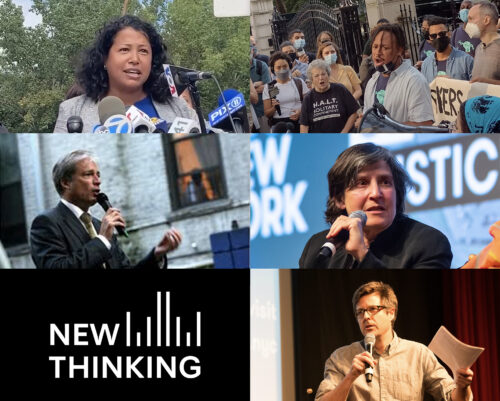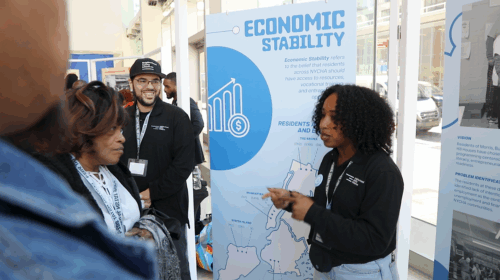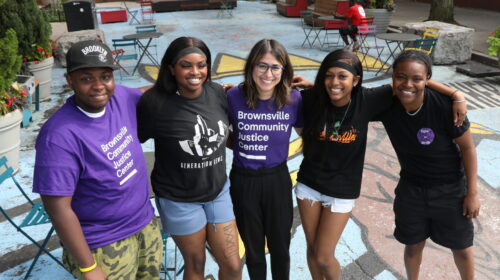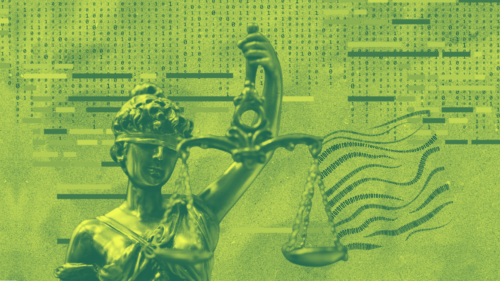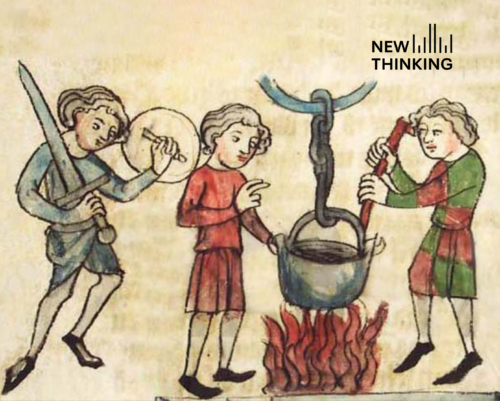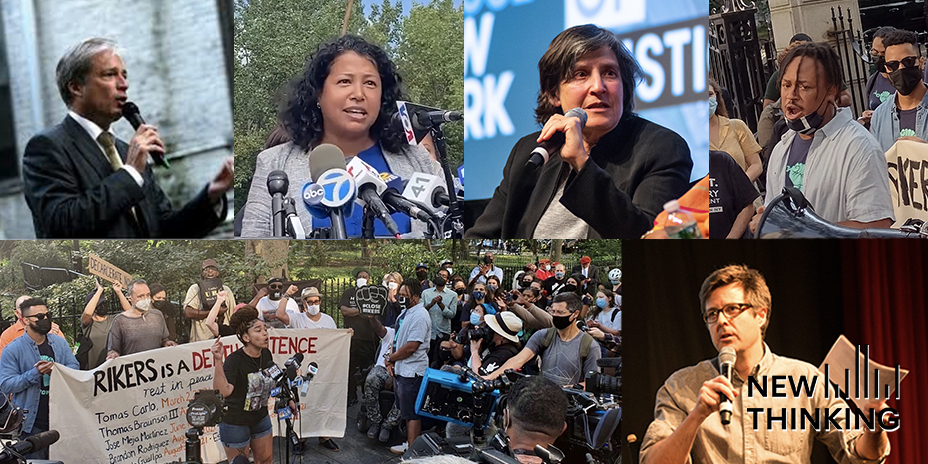
I think the throughline is the utter lack of vision. For as long as we have jails, what is the city’s vision of what it is they should be?
New York City has committed to closing its notoriously violent Rikers Island jail facility by 2027, a seismic shift that would reorient the city’s approach to incarceration.

Rikers’ isolation has been likened to that of a penal colony.
The plan calls for the construction of four smaller modern jails to replace Rikers—jails that would be close to courthouses, not on an isolated island. It also envisions a jail population of only 3,300 people—a remarkable figure when you consider there were almost 12,000 New Yorkers in jail as recently as 2013.
But for almost two years now, the city’s jail population has been growing, not shrinking. And activists see little reason to think the new facilities won’t simply replicate the abuses of Rikers.
Also, Rikers is in profound crisis, again. There is widespread absenteeism among correction officers. And in 2021, deaths reached their highest level in eight years amid horrific reports of people denied medical care, access to lawyers and the court system, even access to bathrooms, food, and water.
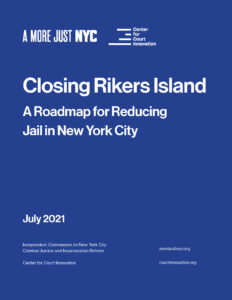
In 2021, we published an updated roadmap for closing Rikers.
There has been a lot of coverage of that crisis, but less focus on what it all means for Rikers’ future.
New York City has a new mayor—Eric Adams. He has committed to closing Rikers, but also made public safety the center of his campaign and is calling for changes to state laws that, if enacted, could see more people jailed before trial.
To talk about the future of jail in New York City, New Thinking convened a virtual roundtable: Brandon Holmes is an early advocate and organizer for close Rikers and the co-founder of Freedom Agenda; Liz Glazer was the director of the New York City Mayor’s Office of Criminal Justice when the close Rikers plan took shape; Alice Fontier is a public defender and the managing director of Harlem’s Neighborhood Defender Services; and Richard Aborn is a former Manhattan prosecutor and the president of the Citizen’s Crime Commission of New York City.
As Aborn tells New Thinking host Matt Watkins, “If we are to be a moral society, we cannot have Rikers Island continue its barbaric practices. The question is, how do we get there?”
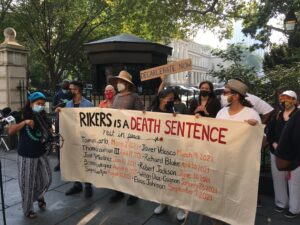
More New Thinking on Rikers
- The Crisis on Rikers Island (09.21)
- Jail-Attributable Deaths (09.19)
- New Jails to End All Jails? (03.19)
- Rikers: An American Jail (07.18)
The following is an annotated transcript of the podcast:
Matt WATKINS: Welcome to New Thinking from the Center for Court Innovation. I’m Matt Watkins.
New York City has committed to closing its notoriously violent Rikers Island jail facility by 2027.
That could dramatically reorient the city’s approach to incarceration.
The plan calls for the construction of four smaller modern jails to replace Rikers—jails that would be close to courthouses, not on an isolated island.
It also envisions a jail population of only 3,300 people—remarkable when you consider there were almost 12,000 New Yorkers in jail as recently as 2013.
But for almost two years now, the city’s jail population has been growing, not shrinking. And activists see little reason to think the new facilities won’t simply replicate the abuses of Rikers.
Also, Rikers is in profound crisis, again. There is widespread absenteeism among correction officers. And in 2021, deaths reached their highest level in eight years amid horrific reports of people denied medical care, access to lawyers and the court system, even access to bathrooms, food, and water.
There has been a lot of coverage of that crisis, but less focus on what it all means for Rikers’ future.
New York City has a new mayor—Eric Adams. He has committed to closing Rikers, but also made public safety the center of his campaign and is calling for changes to state laws that, if enacted, could see more people jailed before trial.
To talk about the future of jail in New York City, I convened a sort of virtual roundtable. You’re going to hear from four different guests. They are Brandon Holmes, an early advocate and organizer for close Rikers and the co-founder of Freedom Agenda; Liz Glazer, who was the director of the New York City Mayor’s Office of Criminal Justice when the close Rikers plan took shape; Alice Fontier, a public defender and the managing director of Harlem’s Neighborhood Defender Services; and Richard Aborn, a former Manhattan prosecutor and the president of the Citizen’s Crime Commission.
I started by asking everyone to give their take on the current crisis at Rikers: just how did things get so bad.
Brandon Holmes speaks first:
Brandon HOLMES: Imagine for over 100 years, a city that is now grown to about 9 million people, took anyone who had a mental health concern, anyone who was accused of a crime—not even proven guilty—anyone who had a drug or substance abuse problem, and put them on an isolated island and told them that they would await their day in court, but then did nothing to manage and sustain an equitable court system, or ensure that people were not abused, or attacked, or sexually assaulted.
So, it gives the other 8,995,000 New Yorkers an opportunity to say, “It’s out of sight, out of mind.” And it’s led to a moment now where staff… When corrections officers say, “We’re unhappy with our work conditions and the deal that we’re getting from the city, we’re not coming to work,” that means somebody doesn’t eat that day; that means somebody doesn’t get to drink water that day, depending on the housing unit they’re in; that means somebody misses a visit with their lawyer, which brings them further from getting released from that hellhole. And it means that people die.
There are a lot of issues with Rikers, but ultimately New York City has decided that they don’t want to invest in the people who are on Rikers—that includes staff, and that includes people who are incarcerated.
Alice FONTIER: It’s total failure of leadership. They had been playing with fire for many, many, many years, allowing things to be held together with quite literally in some places duct tape. It was always about to collapse and about to fall apart and all it needed was one thing out of the ordinary and COVID obviously is very out of the ordinary. So, it gave it a massive push, but it was always about to explode.
Richard ABORN: I think there’s been a profound lack of rigorous management. I think the union has taken advantage of some of the provisions in its contract and greatly reduced staffing levels.
One almost is tempted to say it’s time for federal intervention. I know that the new mayor has appointed a new commissioner, and that commissioner should be given time to try and right things, but if it doesn’t happen, I think we may have to ask the Feds to come in. This can’t continue. This is barbaric.
The ultimate power of the state is to take people’s liberty away and confine them. When the state does that, it has a solemn obligation to make sure that the people that they put into confinement are held in a safe and humane way. We are violating both of those rules every single day.
Liz GLAZER: The city has not really focused on Rikers or on the jails for decades. And the lack of attention is both from the city itself, but also actually from every part of the justice system.
Because what happens at Rikers is also a function of all the other decision-makers whose conduct ends up meaning there are more or fewer people there, that they stay longer, that their cases are swiftly adjudicated.
The second thing is management. You think about the staffing structure. Rikers has the most richly staffed jail on the face of the planet.
And even with things like the sick-out that we’re seeing now… It is just inconceivable why important functions like taking people to clinic, getting them to court, doing all the things that would make life bearable cannot happen.
And finally, I think the throughline is the utter lack of vision. For as long as we have jails, what is the city’s vision of what it is they should be?
WATKINS: Next up, the question of the city’s response to the current months-long crisis at Rikers. Richard Aborn:
ABORN: It’s been dismal. In law, we have something called res ipsa loquitur, the facts speak for themselves. You have to look no further than the front page of some of the papers to understand that conditions there continue to deteriorate from an already unacceptably low level. So, the city has really failed. I think there’s no question about that.
FONTIER: The mayor has not, the prior mayor, had not been willing to grapple with the union and to make hard decisions that would be unpopular with that union. I’m ever optimistic, but thus far Eric Adams has stated he wants to return to solitary confinement, which feels like the wrong direction and not the right.
So there is a lot of issues and quite frankly, the district attorneys and the judges who are asking for bail and then setting it, have a significant part to play in how Rikers is operating as well, because they are the gatekeepers. We’re not in normal times, so why are we continuing to pretend that we are, when the results are deadly?
GLAZER: It is really up to the city to organize and mobilize all the different pieces. And there’s no question that over the past eight years, a lot of money has been put into Rikers that has done everything from programming to training for staff, but the commissioners are really left by themselves.
Maybe the trope for that is the fact that the mayor only went to Rikers one or two times.
I think what we saw as the number of people dying at Rikers shot up just beyond reason or imagination is really that the decision to send somebody to jail had become a matter of life and death. If you think that jails have any role at all in the justice system, that cannot be the standard.
WATKINS: In the spring of 2020, Rikers emerged as an early epicenter of the pandemic in New York City. Along with nonprofits such as the Center for Court Innovation, the city mobilized on an emergency footing to release about 300 people held on shorter sentences into supportive supervision. Results were encouraging, with only a tiny fraction re-arrested on a violent charge. But there’s been no similar effort in response to the current crisis.
In fact, only 10 people were given early release last year, and some of them only had days left on their sentences.
I wanted to know whether people thought the earlier experience of the releases in 2020 suggested some larger lessons for what it would take to close Rikers. Brandon Holmes:
HOLMES: There’s no doubt in my mind, I don’t think there’s any doubt in anybody’s mind, that that is a perfect case study of what the city should be investing in and how quickly they should be making it happen. So at the peak of COVID in April, May 2020, the New York City jail population was the lowest it had been, I think it was since world War II. And that’s almost doubled right now. It’s not because we don’t have those hotel placement programs anymore or because we don’t have the resources or the investments, I think it really is like the appetite is just not there right now politically.
And I think we’re seeing that now with the new variant and we need this next administration to have the same energy that we had at the peak of COVID and to be able to sustain that. Not to just do it for one month because you want to get some good headlines, you want to reduce the risk of people catching COVID and reduce the spread throughout the boroughs. But actually doing it because you want to close Rikers and because you know that we need to decarcerate as fast as possible. Even if closing Rikers, the physical facilities, is five years off, we need to be doing as much as we can in real time to get people out.
FONTIER: I wish I was more optimistic on this front because what we have learned from the fight to first reform the bail laws, and then the fight to try and keep them, which is ongoing, unfortunately: facts and public rhetoric don’t match and you get a really long way by yelling public safety and bail is responsible and lock them up, even though if you actually examine the data that is not at all true.
Yet you can find a story here, a story there, and if you put it in three-inch font in the New York Post and scream about public safety, that’s what people hear and what people believe.
GLAZER: I keep coming back to the pay attention rule. What happened in April of 2020 is that every decision-maker—the D.A.s themselves, the judges, defenders, police—all came together to look person-by-person who was in Rikers. And we saw a pretty rapid reduction in a very short period of time, who contrary to some of the controversy afterwards, were not the people who were driving the shootings.
But one of the problems with the criminal justice system is that it operates and lurches from crisis to crisis. It shouldn’t be that it requires a special effort to analyze who’s in Rikers who could just as well be out—whether they’re city sentenced people, whether they’re folks in on $1,000 bail, whether they have certain physical or mental disabilities that make them better housed someplace else.
That is something that should be part of the daily decision-making, both as people are coming in, and then as a regular review among all the decision-makers as to who is in the standing population.
WATKINS: Closing Rikers is partly a numbers question: can the city get the jail population low enough for Rikers to be replaced? Right now, at about 5 and half thousand, the population is more than 2 thousand over where it needs to be. And given the new mayor Eric Adams’s focus on public safety, it’s not clear the needed reductions are going to happen. In fact, Richard Aborn doesn’t think they will, but that doesn’t dissuade him.
ABORN: I don’t think we should talk in terms of prospects. I think we need to talk in terms of certainty. If we are to be a moral society, we cannot have Rikers Island continue its barbaric practices. The question is how do we get there?
All of the land use authorization roughly envisioned a population in the mid-3,000s. We’re going to have to figure out how to handle the additional 2,500 that are now there, and maybe more.
And the reason I say that is the NYPD is not going to be backing away from arrests. I think the arrest numbers for violent crime will continue to go up. And the courts are going to continue to set bail, where they have the authority to do so. So, we need essentially an overflow plan.
By the way, if the city is successful in returning crime to its 2018 levels—2018, not 2019, and that should be the goal of the city and all the D.A.s—then this issue goes away. I think we’re forever condemned to these numbers while crime is so high, but I don’t expect crime to stay this high.
I know this is about Rikers, but it’s really interesting to watch Eric Adams do this balancing act between understanding that we need to remain very highly focused on violent crime while addressing a lot of the racial injustice that’s taken place in policing and in law enforcement, generally. And that’s what a lot of the D.A.s and PDs are dealing with is: how do you get that balance right? And New York could really lead the way on that.
WATKINS: Liz Glazer, along with former Correction Commissioner Michael Jacobson, recently argued if the city took rigorous advantage of every reduction measure at its disposal, it could drive the jail population as low as 2,200. She says justice dictates jail should be used as sparingly as possible. But a lower population would also have a pragmatic benefit for the plan. Much of the neighborhood opposition to the proposed new facilities has focused on their size.
GLAZER: You want the buildings to be as small as possible to still provide programming and all the necessary services, but to also be a part of the neighborhood. And the bigger that they are, the more controversy and opposition there is from the neighborhood, and that’s problematic. And I think that’s part of what you’re seeing in the hesitation of the current administration about how to go forward.
So what should that number be? So, the city’s goal is to get it to 3,300. Michael and I suggested that there’s actually a way to get it to 2,200. Again, the key is to pay attention. Just think how long people stay in Rikers…
At the point at which you have 25 percent of the population staying for more than a year in a jail, which is supposed to be temporary housing for people not yet convicted, for the most part? That is stunning. And it’s a reflection of the inefficiencies of the entire system, the inability to really work together, just getting people out the door into court.
So, I actually think that the path that we lay out addresses many of the things that Adams is rightly concerned about. He is concerned with what neighborhoods are saying. He’s concerned that officers, as well as incarcerated people, be treated with dignity and respect. And I think he has a kind of relationship with the union that may permit him to improve their lives significantly, even as the population goes down and therefore the number of officers may be reduced.
And the way in which we propose reducing the population, I think is very much in line with his thinking, which is let’s make government actually work and be efficient.
WATKINS: Brandon Holmes also sees overlap between Adams’s stated priorities and the plan to close Rikers.
HOLMES: So it’s like his goals: Close Rikers, fix government dysfunction, attack the major drivers of the incarcerated population. Those are all things that align with advocates’ vision for closing Rikers and getting to that point in 2027 where it is permanently closed, but I think the steps that he wants to take to get there are just not going to have the impact that he thinks they will.
He can be the mayor who comes in and fails to close Rikers, or he can be the mayor who comes in and says, “There’s a plan on the table. There’s advocates who have been doing this for a decade before I became mayor, and I’m going to follow that, and I’ll be the mayor who closes Rikers.”
FONTIER: With our new mayor, I think that campaigning is very different from governing. And he has said both: “I will close Rikers, that is an important thing, it’s a priority,” and “We should rollback bail. More people in solitary.” He can’t have both.
WATKINS: A lot has changed since the city laid out its plan for closing Rikers five years ago. Along with Liz Glazer’s idea of smaller replacement facilities, are there other changes that could be made to the plan to help make closure more likely? Brandon Holmes:
HOLMES: We saw New York City was able to get down to about 3,800 people in custody at the peak of COVID before these facilities were constructed. So why can’t we drive even lower?
But there needs to be those investments in things such as the hotel placement programs that Exodus Transitional Community and others operate. There needs to be more investments in groups like BronxConnect doing violence interruption and youth intervention programs to keep people out of law enforcement contact.
There needs to be investments in mental health housing—I’m talking long-term supportive and transitional housing that gets people out of Rikers but then also into stable living environments where they can continue to access the resources and the care that they need. And with all of that, we can reduce the scale of the planned borough-based facilities. That means we can accelerate the timeline to completion for that.
So, it’s definitely possible. Incoming city council members, we’ve heard from a lot of them who want to support the plan and want to move forward in advancing and improving on the plan, and then we’ve also heard from a lot of council members who are saying, “I don’t know if I support the construction of new jails.” To which we say, “if you don’t support that but you support closing Rikers, you’ve got to have a plan to get to zero incarcerated population by 2027. And if you’re willing to fight for that, we’re willing to fight for that.”
FONTIER: I don’t pretend to say that the borough-based jail plan itself is not controversial, and controversial from all sides—whether you are a developer in the neighborhood, or if you are a prison abolitionist.
But at the end of the day Rikers Island cannot be fixed. So, there are many, many things that can be done about the current plan, but leaving Rikers open is not one of them.
ABORN: I think we are engaged—we, the City of New York—are engaged in one of the biggest experiments ever conducted around diversion of criminal defendants, and I think it’s a healthy experiment.
Prison really should be a last resort. Because we know that even short stints in prison are harmful to the individual who gets incarcerated. There’s no such thing as a good trip to Rikers. It just does not exist.
So, we actually enhance public safety if we can safely keep people away from the island.
I think the piece that needs a lot more attention, that in the same way we are undergoing a reexamination of policing in the United States and in the City of New York, I think we need to undergo a reexamination of what it means to be a correctional officer, the kind of people we hire to be correctional officers, the tasks that we give them, and the training that we give them.
Ultimately, we really need to change the culture of what it is to be a CO in the same way we’re changing the culture of what it is to be a cop.
WATKINS: Richard Aborn is bringing up one of the most bedevilling challenges to the plan to replace Rikers. Opponents of the new jails say if the current Department of Correction is in charge of the facilities, you will inevitably see the creation of four “mini-Rikers.”
The most recent report from the federal monitor appointed to oversee Rikers in 2015 was withering on the topic of the department. The report noted “the department lacks the most rudimentary building blocks upon which progress could be built.” I wanted to hear from all four guests: what role, if any, should the department of correction have in the new facilities?
FONTIER: DOC as it exists now, I’ve lost hope. I’ve lost any faith that they are capable of reforming. One of the issues… So many complicated, political stances here because I believe in unions, I believe in the strength of organized labor. But the union contract, it creates its own set of problems.
And the way that the union is operating… The way that it’s operating, I’ll just leave it at that, is not conducive to economic or efficient or safe management of the facilities.
HOLMES: We are fully advocating for the abolition of the Department of Corrections. They’ve just been proving year after year that, as the incarcerated population decreases, incidents of violence from staff onto people who are incarcerated have increased exponentially.
This agency and the union, COBA—who is actively telling people to not show up to work during a pandemic, who is exploiting unlimited sick time to get their people paid, many of whom have not reported to work in over 10 months and are still collecting full salaries—this is a huge problem.
So, we’re calling for the abolition of DOC and we are fighting for the establishment of a pretrial services agency, an actual agency that has legal authority over the jails—more than what the BOC, the Board of Corrections, currently has.
We think that this punitive model and this punitive agency is a major contributor to how the culture and violence on Rikers exacerbates itself year after year and that’s something that we must change in these new facilities.
GLAZER: We use a lot of euphemisms, and “changing culture” is a euphemism, and it makes it very gushy and hard to understand: what are people really talking about. And the reason for that is that we have not had a clearly articulated vision or goal for what our correction system should be.
So, in, for example, Scandinavian and Northern European countries, there is a very explicit understanding that jails are not warehouses. Jails are places where people are treated with dignity and respect and provided with the kind of supports and tools that they need, not just for a productive life while they have to be in jail, but also for a productive life when they leave jail, so they never come back.
And if that’s your vision, then everything follows it. Buildings by themselves are not going to change behavior, are not going to make people’s lives better. They can assist in that, but the people have to do that.
And that’s why, starting right now, we need to take care of, both people who are incarcerated and officers, and very much change the way we do business.
ABORN: Then there is a big question of whether or not we need to—to use a sort of violent term here—blow up the Department of Corrections, and start it with a tabula rasa, start it with a clean slate, and redesign it. It is clearly malfunctioning.
And that is a very serious challenge for the new mayor to get the Department of Corrections right. There’s a time limit of every day because of the horrors that are taking place at Rikers. But my heavens, we really better make sure we have it right before we open these new facilities.
Let’s not kid ourselves by thinking that we can take somebody who’s been arrested, put them in Rikers, literally treat them like an animal—in fact, we don’t even treat animals that badly; you’d get arrested if you treated an animal that badly—so treat people that badly, and then expect them to come out and be supportive of government, supportive of law, supportive of policing. You can’t have it both ways.
WATKINS: The idea that more jail equals more safety is simple to grasp and deeply entrenched in how crime and punishment are understood in this country. But it’s also likely wrong.
First, jails themselves are some of the least safe places in America. Second, more and more research is showing jails are creating less not more public safety. Even a short jail stay leaves people in worse shape than when they went in, and more likely to come back into contact with the criminal legal system.
In New York City, we pay dearly for this result. It now costs more than a half million dollars per person, per year to detain someone on Rikers.
To close out the conversation, I wanted to hear thoughts from each guest on how we take on this narrative of jails-equal-safety. Brandon Holmes:
HOLMES: When I was an organizer at the New York Civil Liberties Union, we did a police survey project. And one of the questions on that survey was: What makes you feel safe?
And people would list all kinds of things: “I like going to the barber shop when I don’t have anything else to do and hanging out,” “sometimes I’ll walk around and listen to music,” “I’ll go sit at the park and play basketball, or try to get in some pickup games,” whatever the case may be. In zero responses did people say: “Police make me safe.”
And I think if we ask the same question around what makes you feel safe, right? If we had everyone, all the listeners right now, close your eyes and listen to the silence. And now think of where do you feel the safest? Where in your entire lifetime, in your memories, if you think back to when you were a child, do you feel the safest?
And I guarantee you, none of those involve any type of carceral facility, none of those involve any law enforcement unless it was your grandfather who was the sheriff of your local town.
None of it is associated with the ideas that the government perpetuates of things that will keep us safe or that the media will perpetuate that keep us safe.
So I think we need to ask people more in the public’s scene: what makes you feel safe? Tell us. And then it is the government’s responsibility to invest in those things.
ABORN: The great thing about this is we just need to look at the facts. So let’s roll back, and go back 10 years, go back to the beginning of the de Blasio administration, just to pick a point.
In every single year up until mid-2019, we were arresting fewer people, putting fewer people at Rikers Island, releasing more people from state prisons than at any other time in probably the last 40 or 50 years, and the city was getting safer and safer and safer.
The reality is more prisons and more prisoners does not equal more public safety. I’m a former D.A. I am not sitting here saying that no one should ever go to jail. I am not saying that. But not at the levels we’ve been doing, particularly now that we understand how destructive the prison experience is.
GLAZER: As Americans, we’ve gotten used to thinking, if you want to be safe, call the cops and put people in jail.
And so, I think the thing that is most important is not to start first with the justice system when you ask, how do we create safety? But to start first with all the civic services and other things that we know actually make us safe and iteratively make us safer because if people go to school and have a job and have decent housing and all of that, the likelihood that they will ever first touch the justice system, or then touch it repeatedly afterwards, goes way down.
FONTIER: Let’s talk about the economics of this. Why are we spending the amount of money we are spending for something that doesn’t work? So just reinvest part of it, decrease a significant amount, start somewhere. Think for one moment, if we dedicated half a million dollars to each of the people who we cycle through Rikers Island in one year, what you could do with those resources.
For significantly less money, we could give every single person who has gone through that island, stable housing, we could give them job training and support, education if it’s needed, substance abuse treatment if it’s needed, mental health support on a daily basis.
I mean, you could pay somebody to walk around with them all day for a tenth of the price. It is truly the biggest waste of money that you can possibly imagine. And it’s just leading to people literally dying. We’re spending half a million dollars and not even able to keep people alive. That’s stunning.
WATKINS: When you speak about needing some bold leadership, part of that bold leadership is going to have to be withstanding the campaign that would be led from the New York Post denouncing any of this, as they’re already doing with any attempt of change.
FONTIER: Day one of the campaign, you have to stand up and say: “I am doing this. And I know that there will be New York Post headlines every time there is anything that could even be colorably tied to my decision. I don’t care.” Then you have to just continue to not care.
WATKINS: That was Alice Fontier, a public defender and the managing director of Harlem’s Neighborhood Defender Services. Also on today’s episode: Richard Aborn, the president of the Citizen’s Crime Commission of New York City; Brandon Holmes, a co-founder of Freedom Agenda, and Liz Glazer, the former director of the Mayor’s Office of Criminal Justice and the co-editor of Vital City.
For help with conceiving this episode, my thanks to gabriel sayegh of the Katal Center for Equity, Health, and Justice. Thanks as well to Tia Pooler and Courtney Bryan. And an umbrella thank you to Mike Rempel whose work and comradeship has done so much to influence the content of New Thinking.
Today’s episode was edited and produced by me. Samiha Meah is our director of design. Emma Dayton is our VP of outreach. Our theme music is by Michael Aharon at quivernyc.com, and our show’s founder is Rob Wolf. This has been New Thinking from the Center for Court Innovation. I’m Matt Watkins. Thanks for listening.

